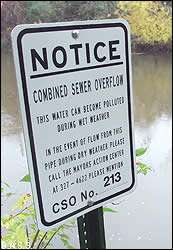
INDIANAPOLIS, Ind. — Every day that it rains or snows, 772 of the nation's older cities and towns face health and environmental threats from outdated sewer systems.
The systems in question are known as CSOs (combined sewer overflows), which are single-pipe sewers that move both sewage and storm water to treatment plants.Those same communities are also struggling with a federal mandate to upgrade their systems. But these improvements come with a high price tag and there are few federal funds available to help pay for them. In fact, the U.S. Environmental Protection Agency estimates that it will take about $45 billion in new construction to address the problem in the coming years."For virtually every CSO community in the nation, this will be their largest public works program ever. It's huge," emphasized Mark Poland, executive secretary of the CSO Partnership based in Richmond, Va.The nation's 772 CSO communities, mainly older cities in the Great Lakes region and the Northeast, are located in 31 states and the District of Columbia. Their brick-lined sewers were built in the late 1800s and early 1900s — before the age of indoor plumbing — to prevent streets from flooding during downpours. In later years, as toilets, sinks and bathtubs were added to homes, the waste was funneled into the same storm sewers.
In the 1970s, the government required cities to lay separate storm and sewer lines. By then, hundreds of cities were left with sewers that work fine in dry conditions but overflow into rivers and streams during wet weather, with bacteria-laced discharges that kill fish, fuel algae blooms and leave a sickening smell that can linger for weeks.
"A quarter-inch of rain is all it takes for us to overflow. And the more that goes in, the more that comes out," said Carlton Ray, an environmental engineer for Indianapolis' Department of Public Works.
Thirty years after the 1972 Clean Water Act began prodding cities and industry to begin cleaning up their waters, only about a third of the 772 communities are now complying with minimum federal CSO controls. "No one has ever gotten elected to public office promising to fix their sewer system. It's just not a popular thing to spend money on," said John Schombert, executive director of the Three Rivers Wet Weather Demonstration Project in the Pittsburgh area.
A 1994 EPA policy gives communities the flexibility to determine the most cost-effective ways to address their overflows, given their finances. There's no specific deadline, but doing nothing can result in fines and stymie a community's growth.Indianapolis plans to spend more than $1 billion over the next 20 years in an effort to reduce its sewer overflows by about 80 percent by expanding its sewer plants and likely building huge underground storage tanks to capture most of its overflows for later treatment. The average sewer rate for the city's 780,000 taxpayers is expected to climb 40 percent by 2020 to help pay for it.
Threatened by the EPA with $275 million in fines, officials in the Pittsburgh area are devising a 12-year, $3 billion plan. Nearby, roughly 80 more communities are bracing for sewer rate hikes to help pay to clean up the water flowing into the area's Allegheny, Monongahela and Ohio rivers, waters that provide 90 percent of the local drinking water.
The threat of fines also prompted Atlanta to come up with its nearly $2 billion sewer fix, which includes boring three tunnels through a total of 20 miles of solid granite more than 100 feet beneath the city. These giant tunnels would serve as huge storage tanks capable of storing about 300 million gallons of tainted storm water until precipitation subsides, at which point their contents would be funneled into two new treatment plants.

